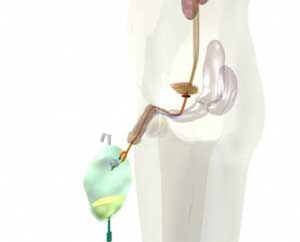Q: What are indwelling catheters?
A: There are two approaches to indwelling catheters:
A catheter may be inserted through the urethra into the bladder.
This is frequently called a �Foley�.
A catheter may be placed surgically through the belly wall directly into the bladder.
This is called a �suprapubic tube�.
Q: What is involved with a Foley catheter?
A: Foley catheters involve passing a catheter through the urethra into the bladder.
After it is inserted a small balloon that is built into the catheter is inflated to keep the catheter in place.
The catheter is then attached to a collection bag that can be placed on the leg or beside the bed or wheelchair.
The collection bag will generally need to be emptied twice a day and the catheter usually is changed once a month.
Q: Would I be able to drink as much liquid as I would want with a Foley catheter?
A: In contrast to many of the other bladder techniques, a large water intake is desirable with an indwelling catheter.
A large water intake seems to decrease the infection rate and washes out small stones in the urine that might clog the catheter.
Q: What are the advantages of an indwelling catheter?
A: Many people choose indwelling catheters because they are convenient.
You put it in, you empty the bag twice a day, and change the system once a month and there is not much else to it.
Other people choose it because they don�t like to worry about how much they drink.
Accidents are quite rare with these catheters.
Q: What are the disadvantages of an indwelling catheter?
A: You have to get used to having the catheter and the collection bag with you all the time.
The catheter can be removed briefly during sexual intimacy, but it needs to be reinserted relatively soon afterwards or urine accidents or a fever may develop.
Most people will notice a slight odor with an indwelling catheter, probably from the collection bag.
The most important disadvantage of the indwelling catheters has to do with the chronic infection.
After a few days, any catheter left in the bladder will result in a urinary tract infection.
This is a reality that you have to live with if you choose this method.
Q: Are these infections a major problem?
A: Usually such infections are not a major problem as long as the catheter is changed once a month and you drink plenty of water to keep the urine thin and flowing well.
It may seem like a good idea to treat the germs that are in the bladder with antibiotics, but most experts find that over the long haul this makes things worse rather than better.
Q:What medications are used to treat these infections?
A: Antibiotics are generally used only when the person develops a fever indicating probable kidney infection.
Q: Are there any other problems with indwelling catheters?
A: Most people with indwelling catheters will have some amount of bladder stone development, but this rarely causes problems.
If the stones and gravel accumulate on the catheter the tube may become blocked.
When this occurs bladder pressure may build up and cause either kidney infections or autonomic dysreflexia.
For reasons that are unknown, persons who use an indwelling catheter for many years have an increased risk of bladder cancer.
This generally doesn�t occur until after ten years of use.
Your physician may recommend a special bladder evaluation called a cystoscopy after you have had the catheter for about 10 years and every few years after that.
This is a relatively simple outpatient procedure.
Q:Are there different problems with indwelling catheters for men and women?
A: For men with Foley catheters (but not suprapubic tubes) the catheter passes very near the prostate gland and the opening of the sperm ducts.
Probably because of this, prostate infections and infections of the tubes to the testicles may occur.
These infections can usually be treated as an outpatient with a few weeks of antibiotics, but they sometimes recur.
Infections of the sperm ducts may impair fertility.
There are no known gynecological problems associated with the use of an indwelling catheter.
Q: What would I do to make sure that an indwelling catheter technique worked well for me?
A: There are four key elements in making an indwelling catheter work well:
1. A large intake of fluids is desirable. Drinking at least 3 quarts of liquid per day is recommended.
2. The catheter should be changed regularly to prevent it from becoming blocked with small stones.
3. Care must be taken not to put pressure or traction on the catheter as this may cause it to damage internal structures or even come out.
4. Regular contact with your health professional is very important.






